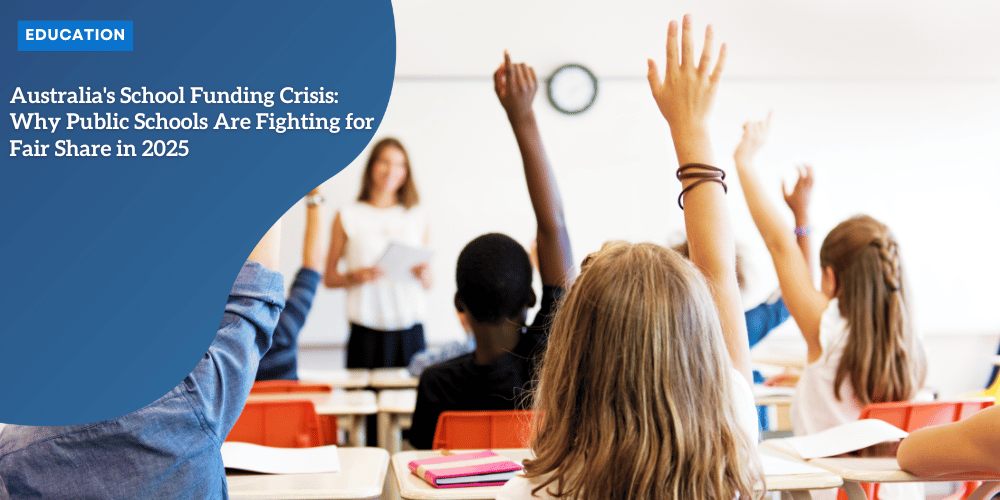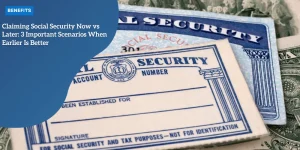Australia’s School Funding Crisis: Why Public Schools Are Fighting for Fair Share in 2025

Anúncios
The Growing Divide in Australian Education
The battle over school funding in Australia has led to significant disparities in resources and quality of education between public and private schools.
In 2025, the funding imbalance has grown even more pronounced, with private schools receiving unprecedented levels of government funding, while public schools continue to struggle.
Funding Disparities in 2025
Public schools, which educate the majority of Australian students, are operating with severely limited resources. According to recent data, a staggering 98% of public schools fall below the minimum funding requirements.
These institutions are unable to provide basic educational materials, often forcing teachers to spend out of their own pockets to supply classrooms with essential items like stationery.
Anúncios
On the other hand, private schools are thriving with record levels of government support. The Australian government allocates an astonishing $51 million daily to private schools, which may charge fees as high as $50,000 annually.
This vast financial influx has allowed private schools to offer better facilities, smaller class sizes, and extensive extracurricular activities, further widening the gap between private and public education.
Public Schools Struggling
Despite serving the bulk of the student population, public schools are left to navigate their way through financial hardships. Many public school teachers are dipping into their own salaries for essential classroom supplies, a situation putting immense strain on their finances and morale.
The lack of adequate funding challenges the ability of public schools to offer a high-quality education, leading to a widening divide in educational outcomes between public and private school students.
Private Schools’ Surplus
Private schools, bolstered by substantial government funding, do not face the same financial constraints. With access to extensive resources, these schools can provide a premium education experience, which includes advanced learning environments, state-of-the-art facilities, and comprehensive support services.
Anúncios
Such advantages are typically out of reach for public schools hampered by budgetary restrictions.
Impact on Educational Equity
The stark contrast between the funding of public and private schools in 2025 has raised significant concerns about educational equity. Critics argue that the current funding model favors privileged private schools, leaving public schools and their students at a disadvantage.
This situation perpetuates a cycle of inequality where the socioeconomic background of students largely influences the quality of education they receive.
The growing financial divide poses serious questions about the fairness and effectiveness of Australia’s school funding system. Urgent reforms are needed to ensure that public schools, which educate the bulk of the nation’s children, receive the necessary support to provide a high-quality education for all students, regardless of their background.
Australia’s education system stands at a crossroads, grappling with how to balance governmental support between public and private sectors while addressing systemic inequities.
Finding a resolution in this ongoing debate is key to achieving a more equitable and effective educational landscape.
 Everyone has the right to equal education
Everyone has the right to equal education
Understanding the Funding Numbers
Australia’s education system faces a critical challenge in 2025, with an alarming funding disparity between public and private schools.
This divide drastically impacts the quality of education and resources available, further widening the gap in educational outcomes across the country.
Private Schools’ Lucrative Funding
Private schools in Australia are experiencing unprecedented levels of government support. Daily, these institutions receive a whopping $51 million from the Commonwealth.
This continuous influx of taxpayer dollars fuels elite private schools, enabling them to provide top-tier facilities and resources that many public schools can only dream of.
Private schools also impose hefty fees on their students. While the average fee for Year 12 students is around $21,000 in Victoria and $16,000 in New South Wales, some of the most elite schools charge upwards of $50,000 annually.
This financial barrier not only limits access to these institutions to affluent families but also highlights the stark contrast between the public and private sectors.
Public Schools Struggling Below Minimum Standards
On the flip side, 98% of public schools operate below the minimum funding standards. These schools serve the majority of Australian students, yet they continuously grapple with insufficient resources.
Teachers in these underfunded schools often find themselves dipping into their own pockets to purchase basic supplies like stationery for their students. This disparity is not just unfair but hampers the quality of education that public school students receive.
Frustration and Inequalities
As this imbalance persists, frustration mounts among educators, parents, and policymakers. The evident inequities provoke heated debates and calls for reform.
Critics argue that while private schools are swimming in money, public schools are left to flounder, affecting the overall standard of education in the country.
Despite these issues, there remain vocal supporters of the current funding system who assert that all students, irrespective of their school’s status, deserve government support.
However, this perspective does not alleviate the funding shortages plaguing public schools or the out-of-pocket expenses burdening public school teachers.
The urgent need to address these disparities is apparent. The debate over equitable government funding for schools continues to be a crucial issue in Australia.
Moving forward, the focus will be on finding a balanced solution that ensures fair and adequate funding for both public and private schools, supporting the education of all Australian students.
The Political Battlefield
The debate surrounding education funding in Australia is heating up in 2025, with Independent Schools Australia (ISA) and the Greens at the forefront.
This has turned into a significant political battleground with both sides fiercely advocating for their visions of a fair education system.
Independent Schools Australia’s Criticism
Independent Schools Australia CEO, Graham Catt, has been vocal about his discontent with the Greens’ education policy. He accuses them of engaging in “divisive class-war rhetoric,” which he believes unfairly targets Independent school families.
According to Catt, ISA fully supports the idea of public schools being fully funded but insists that it should not come at the expense of Independent schools.
“Promoting the idea that funding public schools fairly means stripping funding from Independent school students is just wrong,” Catt said [source](School funding: Fair or flawed.docx).
Catt further emphasized that the upcoming elections would see ISA making sure every Independent school parent is aware of who supports them and who aims to make their child’s education more expensive.
As a result, ISA has launched a targeted advertising campaign in 17 key electoral seats, highlighting their stance and rallying support among Independent school parents.
Greens’ Proposal for 100% Schooling Resource Standard Funding
On the other end of the spectrum, the Greens propose a policy to fund all schools, both public and private, to 100% of the Schooling Resource Standard (SRS) by 2026.
Senator Penny Allman-Payne, the Greens’ spokesperson for Primary and Secondary Education, tore into the current funding model, pointing out that private schools receive $51 million daily from the Commonwealth, while 98% of public schools fail to meet even the minimum funding requirements [source](School funding: Fair or flawed.docx).
Allman-Payne highlighted the steep fees in private schools, with some charging over $50,000 per year, while public school teachers often have to use their own money to buy basic supplies for their classrooms.
The Greens’ policy aims to address these disparities by abolishing public school fees and providing $800 back-to-school payments for every public school child.
Allman-Payne believes this will significantly aid parents and carers struggling with out-of-pocket costs associated with schooling.
ISA’s Targeted Advertising Campaigns
To counter the Greens and bolster their position, ISA has not only condemned the Greens’ approach but has also taken actionable steps. Their advertising campaign, launched starting last week, aims to sway voters in key seats where Independent school families constitute a significant portion of the electorate [source](School funding: Fair or flawed.docx).
ISA’s efforts are centered around portraying the Greens’ policies as detrimental to the interests of Independent school students.
The campaign is designed to create awareness among voters about who is genuinely supporting their educational choices and who might make those choices more costly.
The unfolding debate is symptomatic of the broader tensions and unresolved issues in Australia’s education funding landscape. As both sides continue their offensive, it’s clear that the direction of educational reform will significantly shape the country’s future.
unteers for the changes in education funding, which will have massive implications for all Australian students.
Proposed Solutions and Reform
Abolishing Public School Fees and $800 Back-to-school Payments
One of the most transformative proposals from the Greens is the plan to abolish public school fees. This would essentially mean that education in public schools would be completely free, ensuring that no child is left behind due to financial constraints.
In addition, the Greens propose to give every public school child an $800 back-to-school payment.
This direct financial assistance aims to alleviate the pressure on families struggling with school-related expenses and to ensure that students have access to the necessary supplies and resources to thrive.
Senator Penny Allman-Payne emphasized the importance of this initiative, stating that it would significantly reduce the out-of-pocket costs for parents and carers.
By eliminating school fees and providing additional financial support, the Greens hope to create a more equitable educational landscape where all students, regardless of their socio-economic background, can succeed.
Full Public School Funding by 2026
The Greens are also pushing for full funding of public schools by 2026. They aim to meet the Schooling Resource Standard (SRS) for all schools, ensuring that every institution has the necessary resources to provide quality education.
This proposal is a stark contrast to the current situation where 98% of public schools fall below the minimum funding requirements.
The Greens argue that their plan would address the systemic inequities in the education sector and provide a level playing field. By committing to fully fund public schools, they believe that students will receive the support they need to excel academically and socially.
Debate Over Equitable Distribution of Government Funding
A contentious issue in the education funding debate is the equitable distribution of government funding across both public and private sectors.
Under the current model, private schools receive significant government support alongside their substantial tuition fees, leaving public schools under-resourced.
The Greens propose to recalibrate this funding model to ensure that public schools receive the necessary support. They argue that while private schools should still receive government funding, it should not come at the expense of public education.
This proposal has faced criticism, particularly from Independent Schools Australia (ISA), which claims that such changes would unfairly penalize private school families.
Next Steps in the School Funding Debate
As Australia moves forward, the debate over school funding continues to be a polarizing issue. The implementation of the Greens’ proposed solutions would require broad political support and may face significant opposition.
However, the urgency for resolution is clear, emphasizing the need for a fair and equitable education system that benefits all students.
By addressing these key issues, Australia can move towards a more balanced and inclusive education system, ensuring that every child has the opportunity to succeed regardless of their economic background.
The Path Forward
Minority Government’s Role in Reform
Entering 2025, Australia’s political landscape may tilt toward a minority government. This potential shift brings transformative education reforms into sharper focus.
The Greens have championed a comprehensive plan to revamp the funding model, aiming to abolish public school fees and deliver $800 back-to-school payments.
With a minority government almost certain in the next term, the Greens plan to leverage their position in post-election negotiations to push for these crucial reforms.
Balancing Student Support and Systemic Inequities
While calls for increased funding to public schools grow louder, it’s essential to strike a balance that ensures all students receive the support they need.
The goal is to lift public school funding to 100% of the Schooling Resource Standard (SRS) by 2026. This endeavor seeks to address systemic inequities that have long plagued Australia’s education system.
Many argue that a more equitable distribution of government funding is crucial. With private schools currently receiving $51 million daily from the Commonwealth, there’s a stark contrast to the situation in public schools.
The Greens’ policy aims to correct this imbalance, ensuring no student, regardless of socioeconomic background, is disadvantaged.
The Urgency for Resolution
As debates over school funding intensify, the urgency for a resolution becomes apparent. There is growing frustration among educators, parents, and policymakers over the current funding disparity.
The Greens’ vision promises a fair allocation of resources, addressing the core issues of inequity and ensuring quality education for all Australian students.
Find out more at:
Resolving this funding crisis is not just about numbers; it’s about providing every child with an equal opportunity to succeed. Failure to act swiftly risks perpetuating the inequalities that have defined the system for too long.
The path forward requires courageous decisions and a commitment to equitable education reform.






